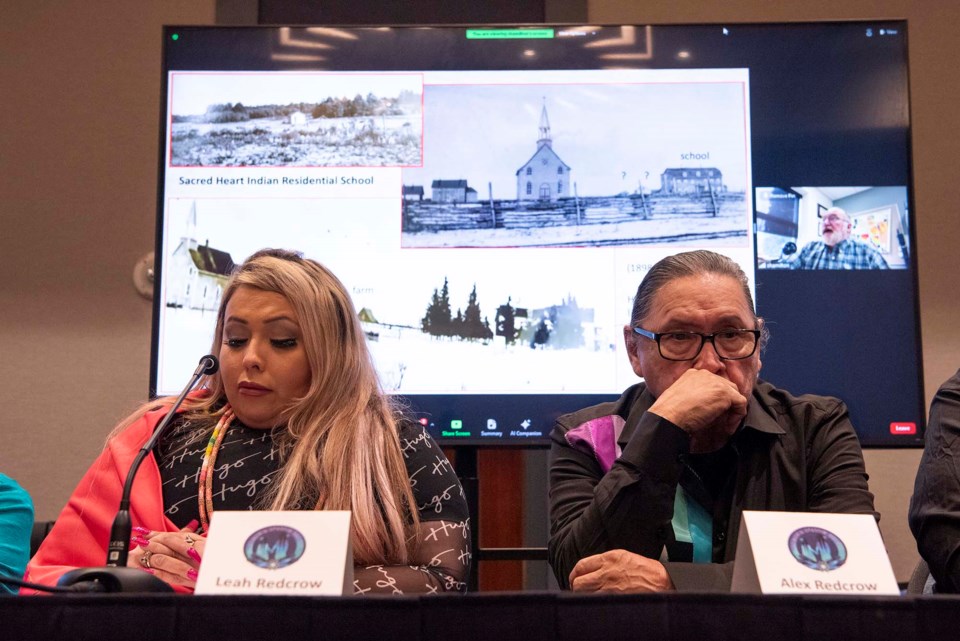Warning: this story contains disturbing details.
An investigative team plans to dig up what they believe is a mass grave this summer in Saddle Lake to give residential school students they suspect are in it proper burials.
Members of the Acimowin Opaspiw Society gave an update at the River Cree Resort in Enoch Cree Nation Jan. 24 of their investigation into students who died or went missing at the Sacred Heart Residential (AKA Blue Quills) Residential School. The society is a non-profit that represents survivors of the Blue Quills school and their descendants.
The school operated in what is now Saddle Lake Cree Nation from 1898 to 1931 near the Sacred Heart Catholic Cemetery on the west side of the reserve. The school was rebuilt near St. Paul in the 1930s and operated there until it closed in 1990.
The investigation
In 2004, Saddle Lake resident Jason Whiskeyjack stumbled upon what is believed to be a mass grave when digging a grave in the Sacred Heart cemetery about 100 m north of the foundations of the old Blue Quills school, said AOS executive director Leah Redcrow.
“He saw numerous child-sized skeletal remains contained within a communal pit. The remains were not protected in caskets and instead were wrapped in white shrouds.”
Redcrow said community members reburied the remains and initially did not realize their significance. As more remains turned up, residents realized they might be connected with the former Blue Quills school. The AOS formed in around 2021 to head up an investigation.
The group has used aerial photos, church documents, eyewitness accounts, and ground-penetrating radar to try and pinpoint the location of the mass grave and other unmarked burials in the region. Investigators have found evidence of grave shafts at the site and, last October, discovered exposed bones from what appears to be a child who was less than five years old near the site.
Redcrow said church records show 335 recorded student deaths at the Blue Quills school while it was in Saddle Lake, but do not mention any mass burial sites. Investigators don’t yet know the identity or number of the people in this grave, but suspect some may be students known to have gone missing from the school in the 1920s.
Remains at risk
Redcrow said the remains in the mass grave are buried as little as eight centimetres deep and will be exposed by erosion or animals without action.
“This is a crisis,” said Redcrow.
“These skeletal remains of these children, because they are not protected by caskets, are being disinterred by animals. We cannot allow this to happen to these children.”
Redcrow criticized the RCMP and Alberta’s chief medical examiner for refusing to help with this investigation, noting that mass graves were a violation of international law. The group was working with the federal government and the International Commission on Missing Persons on this matter as a result. She also criticized the Sisters of Charity for not releasing records essential to the group’s research.
Redcrow said the society plans to do a forensic recovery effort of this site this summer in order to try and identify the people in it and give them proper burials.
Redcrow asked anyone whose relatives had connections to the Blue Quills school to attend community meetings this February and March to discuss next steps. The first two meetings will be Feb. 13 at the Onchaminahos Saddle Lake School and Feb. 15 at the St. Paul recreation centre. Other meetings will be held in Calgary, Fort McMurray, Lac La Biche, and the Beaver Lake, Enoch, Goodfish Lake, and Heart Lake First Nations. (See www.acimowinopaspiw.ca for details.)
“All of us up here (the board), we have family members who died in this residential school,” Redcrow said.
“No human being deserves to have their bodies scavenged by animals.
Redcrow also urged people to stop destroying church buildings, as those structures contained vital information on students in unmarked residential school graves.
“Retribution prevents meaningful reconciliation and the healing our people require from the dark legacy of Indian residential schools.”
Questions on the investigation should go to [email protected].




